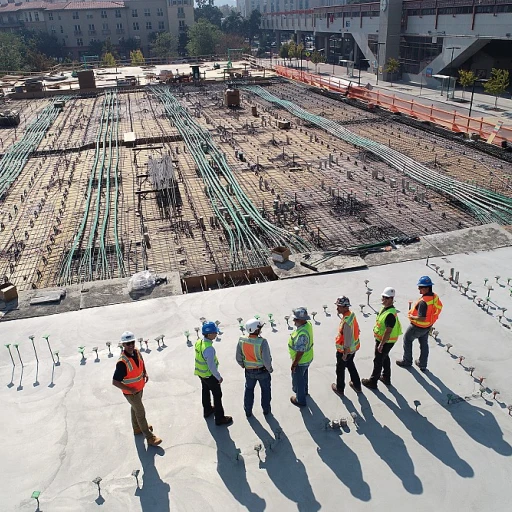
Understanding the Importance of Career Development Programs
The Role of Career Development in Employee Satisfaction
Career development programs play a pivotal role in enhancing employee satisfaction and retention. When employees see a clear path for growth and advancement within a company, they are more likely to stay engaged and committed to their roles. This not only benefits the employees but also contributes to the overall success of the organization.
Aligning Career Development with Business Objectives
For a career development program to be effective, it must align with the organization's long-term goals. Understanding the business objectives helps in crafting development plans that support both the company's growth and the professional aspirations of its employees. This alignment ensures that the skills and capabilities being developed are relevant and beneficial to the organization.
Creating Opportunities for Skill Enhancement
Providing employees with learning opportunities is crucial for their professional growth. Training programs, mentorship programs, and other learning initiatives help employees bridge skills gaps and prepare for future roles. By investing in employee development, companies can foster a culture of continuous learning and improvement.
Building a Culture of Continuous Learning
Organizations that prioritize employee growth and development create a culture of continuous learning. This culture encourages team members to pursue their career goals actively and seek out new challenges. It also helps in identifying potential leaders within the organization who can drive future success.
For more insights on creating effective development plans, consider exploring this resource that offers guidance on crafting impactful employee development strategies.
Identifying Organizational Needs and Goals
Assessing Organizational Objectives
When implementing effective career development programs, understanding the specific needs and goals of your organization is crucial. This begins by analyzing the company’s strategic objectives and how employee career growth aligns with those targets. Identifying what skills and competencies are essential for your organization can guide the creation of tailored training programs that propel both company success and employee development.
Aligning with the Business Vision
For career development initiatives to be successful, they must align with the broader business vision. Consider the current industry trends and future projections to craft programs that not only respond to present needs but also anticipate future demands. This strategic alignment ensures the workforce is prepared for evolving challenges, thus fostering long-term business growth.
Analyzing Workforce Demands
To create impactful career development programs, it is essential to examine the current capabilities and aspirations of your team members. Conducting surveys or focus groups can provide insights into employee career goals, preferred learning opportunities, and perceptions of growth opportunities. This information helps in designing development plans that are both relevant and motivational.
Crafting Purposeful Development Goals
A thorough needs evaluation will facilitate the establishment of focused development goals. These goals should bridge any skills gaps discovered during the assessment phase and align with overall business objectives. Clear and measurable development goals assist in tracking progress and provide a structured path for both the organization and the employees to follow as they work towards mutual growth.
Maintaining Accountability and Feedback
Once the organizational needs have been identified, and development goals set, accountability measures become essential. This can involve periodic reviews and dependable feedback mechanisms for continuous improvement. Moreover, a structured approach to addressing and correcting any obstacles encountered, such as crafting effective warning letters, maintains the program’s momentum and ensures stakeholder engagement learn more here.
Designing a Comprehensive Career Development Framework
Establishing a Solid Framework for Employee Growth
Creating a well-structured career development plan is pivotal for fostering success within any organization. A robust framework serves as a blueprint that not only aligns development efforts with company goals but also addresses the personal and professional aspirations of employees. In order to devise a comprehensive approach, consider the following integral components:- Align Development Goals with Business Objectives: To ensure meaningful outcomes, it is crucial to synchronize employee career development goals with the broader mission and vision of the company. This alignment helps motivate employees, offering them a clear path to contribute to the organization’s success while concurrently achieving their personal career goals.
- Identify Key Competencies and Skills Requirements: Analyzing the skillset required for evolving roles within the organization is vital. By identifying these competencies, development programs can effectively bridge the skills gap, thus better preparing employees for future responsibilities. This proactive approach not only prepares the workforce for changes but also inspires confidence in their career paths.
- Diverse Learning Opportunities: Offering varied learning opportunities, such as mentorship programs, training, workshops, and e-learning modules, enriches employee development. Tailoring these programs based on skill levels and career stages ensures that all team members benefit from training development crafted to meet their unique needs.
- Systematic Career Path Mapping: Clear career mapping helps employees visualize their potential growth within the organization. By outlining potential career paths, employees are empowered to take charge of their own development journey, thus fostering increased engagement and retention.
- Feedback Mechanisms: Implementing effective feedback systems ensures continuous improvement of the development programs and helps employees understand their progress and areas for improvement. Constructive feedback is invaluable for making informed adjustments to the development plan, ultimately fostering both personal and organizational growth. To learn more about how feedback can enhance career development initiatives, explore effective ways to provide interview feedback.
Integrating Technology and Tools
Leveraging Modern Solutions for Workforce Growth
In today's rapidly evolving business landscape, adopting modern technology is not just beneficial — it's essential to effective career development programs. Organizations that successfully integrate technology into their career development frameworks create a conducive environment for employee growth and achievement. Firstly, implementing robust digital platforms can greatly enhance training programs. These platforms offer flexible learning opportunities that cater to individual employee needs and career goals. This is crucial as employees seek continuous learning and professional development to bridge skills gaps and align with their career paths. Furthermore, technology facilitates personalized development plans by allowing employees to access resources tailored to their specific development goals. This personalization helps ensure that team members are not only gaining new skills but are also aligning with the organization's long-term objectives. Incorporating advanced analytics into employee development programs helps track progress and measure success. By using data-driven insights, companies can adjust training development initiatives in real-time, ensuring that employee growth aligns with business needs. Additionally, mentorship programs can benefit from tech integration through virtual collaboration tools, enabling effective knowledge transfer and leadership development regardless of geographical limitations. Overall, embracing technology in career development fosters an innovative organizational culture that motivates employees and supports their aspirations. This not only aids in achieving immediate business goals but also builds a sustainable workforce ready for future challenges.Engaging Stakeholders and Securing Buy-In
Securing Involvement and Active Engagement
For career development programs to be successful, it's crucial to involve a wide array of stakeholders from different levels of the organization. Engaging stakeholders in career development requires clear communication and a demonstration of how these programs align with the company’s professional growth goals.
Firstly, understanding and aligning with business objectives ensures that development programs are seen as valuable investments. This alignment can be communicated through collaborative meetings and presentations, clearly linking career development to overall business success.
Moreover, obtaining buy-in from leadership involves illustrating the long-term benefits. Emphasizing the role of training programs in fostering employee retention and leadership readiness is key. Here are some effective tactics to engage stakeholders:
- Regular Updates: Keep stakeholders informed about the progress and achievements of the development programs through regular reports and meetings.
- Success Stories: Share stories of employee growth and development resulting from these programs. Real-life examples can be persuasive.
- Feedback Mechanisms: Create channels for stakeholders to provide feedback, ensuring the programs remain dynamic and responsive to company needs.
Additionally, fostering a culture where learning and growth are valued can help in securing broader support from all team members. Encouraging employee career participation through mentorship programs and learning opportunities makes the process inclusive, ensuring that development goals permeate throughout the organization.
Ultimately, bridging the gap between individual career paths and the organization's development objectives calls for a collaborative environment. By securing widespread involvement, companies not only elevate their workforce but also drive their own internal growth to meet evolving market demands.
Measuring Success and Continuous Improvement
Evaluating Outcomes and Encouraging Consistent Growth
Measuring the success of career development programs is crucial to ensuring their effectiveness and aligning with both the organization’s and employee's goals. By establishing clear metrics and feedback mechanisms, companies can assess whether they are truly helping employees grow and thrive.- Setting Transparent Metrics: Define specific, measurable outcomes aligned with the program’s goals. This could include employee retention rates, promotion rates, and skills acquired by team members.
- Regular Feedback Loops: Encourage open communication for employees to express their experiences with the development programs. Regular feedback helps identify areas for improvement and provides insights into employee career aspirations and growth opportunities.
- Utilizing Employee Surveys: Surveys can capture quantitative and qualitative data on how employees perceive the impact of mentoring programs and training initiatives. Understanding their learning journeys can highlight aspects that need alteration or reinforcement.
- Performance Reviews and Career Assessments: Regular performance reviews are essential in understanding how effectively employees are meeting their career goals. They also offer a platform to discuss personal development plans and set new objectives.
- Technology-Driven Insights: Leverage technology to track employee training progress, identify skill gaps, and tailor development plans accordingly. Utilizing data analytics can enhance the understanding of both individual and collective growth trajectories.
- Encouragement of Continuous Learning: Encourage a culture of continuous learning by offering varied development opportunities. This includes specialized training programs, leadership courses, and access to learning platforms. The emphasis on ongoing education underscores the company’s commitment to long-term employee growth.
- Recognizing and Rewarding Contributions: Acknowledge the achievements of employees who have excelled due to their involvement in development programs. This not only boosts morale but encourages others to engage more fully in available learning opportunities.












